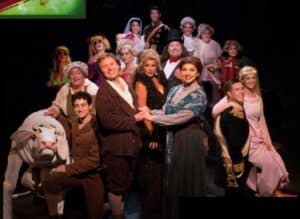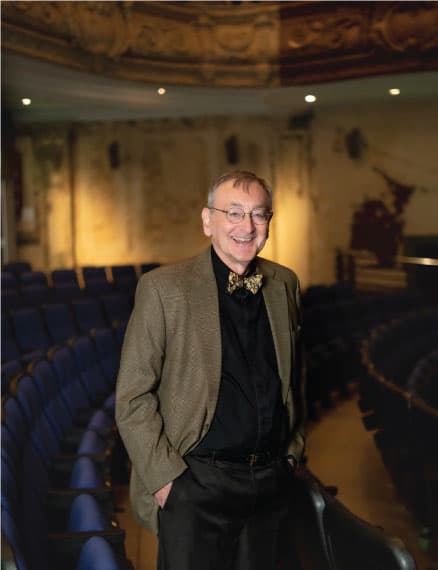Strong Production, Profound Show: INTO THE WOODS at Toby’s
Posted on BroadwayWorld July 21, 2015
As these pages evidence, I’ve reviewed quite a few productions at Toby’s Dinner Theatre over the years;[1] its current revival of Stephen Sondheim and James Lapine‘s Into the Woods is the strongest of the lot.
For whatever reason, dinner theater may not always receive the respect it deserves; as an experience half-thespian and half gastronomical, it is theater for the masses, and relies on the services of journeyman performers rather than great stars. But none of these traits stand as an impediment to high standards or thrilling performances. This rendering of Into the Woods is a case in point. The show is a heavy lift: it calls for a large cast of dramatic leads who can both act and sing – and the score is complex, demanding well-trained voices and perfect timing. And even with these qualities, the cast is called upon for more: mere Broadway pep and razzamatazz will not put it across. This is that rarest of musicals, a work of profound drama. The actors must teach as much as they sing and dance and emote.
The profundity comes in what might on the surface be a surprising place: the folklore passed on from parents to children under the deceptively superficial name of fairy tales. Fairy tales are timeless because the kitchen drudge who yearns to become a princess, the little girl vanquishing a wolf encountered on the way to grandmother’s house, the simpleton who sells the family cow for a handful of magic beans, and their kindred, are archetypes of each of us, at various moments in the trajectories of our lives. As such, there is actually nothing superficial about them. By mashing up these stories, composer/lyricist Stephen Sondheim and book author James Lapine demonstrate the common dynamics in these tales that enable them to speak so powerfully to us.
As most theatergoers know, the stories start with a common sense of longing. As we discover Cinderella (Julia Lancione), the Baker and his Wife (Jeffrey Shankle and Priscilla Cuellar), Red Riding Hood (Sophie Schulman), and Jack (of Beanstalk fame) (Jimmy Mavrikes), the common phrase in their song is “I wish.” To pursue these wishes (to go to the festival, to have a child, to visit granny, to sell the cow), they are compelled to enter “The Woods,” which are far more than any mere geographical Black Forest. These are simultaneously the place where anything can happen (like the dreamlike forest in A Midsummer Night’s Dream) and a metaphor for early encounters with risk and growth that come into each of our lives. Mostly, things go well for the heroes and heroines, as befits their status in the tales about them. They not only succeed, but they learn much about the world and themselves, leading to some degree of mixed emotions. As Red Riding Hood summarizes her encounter with the wolf: “And he made me feel excited/-Well, excited and scared.” Ditto Cinderella fleeing from her prince: in this version of the story, there is no short-lived pumpkin coach whose expiration forces her to leave the palace, but she simply finds herself unable to process immediately the erotic promise of the encounter and needs to break it off for the moment.
As we proceed, we also learn that these tales are not only about young people finding their mates or coming to terms with their sexuality or starting their families. They are about age as well as youth, especially the familiar dance of closeness and separation between parent and child. This is most poignantly true of the Witch (Janine Sunday) and Rapunzel (Katherine Riddle). What Rapunzel sees as the mother interfering with her independence and her relationship with her Prince (Justin Calhoun), the Witch sees as protecting her daughter from a terrifying and deadly world. They are each wrong – and right.
Act I of course ends with all problems resolved, and all the heroes and heroines successful, as the ancient tales ordain. But Act II is where the real genius of the show goes to work. Like Act II of the Fantasticks, but far more richly, it takes as its premise the obvious truth that every happy ending is the beginning of another tale, and that when you have nowhere to go but down, down is where you have to go. Lapine and Sondheim ask themselves and us what these same archetypal characters could tell us about ourselves if they were allowed to play out their strings further, beyond the happy endings. The answers to that question are what make this musical one of the great evenings of theater.
The characters are all compelled by circumstances to go back into the woods, and this time they encounter there such things as infidelity, divorce, the death of parents, the loss of children, abandonment, catastrophe – and overarching this the absence of a narration (the narrator, played by Russell Sunday, becoming a casualty of a lethal giant) or any other authoritative guidance as to the choices that need to be made. As one of the characters observes: “The path has strayed from you.” The unsettling conclusion: “You decide what’s right / You decide what’s good.”
This is all incredibly sad and confusing, not to mention frightening, and yet as the core of surviving characters gels, so does the indomitability of the human spirit they evince. This story too, it is suggested by the moving final number,Children Will Listen, should be told our children.
To me, this is Sondheim’s greatest musical. As great as he is and abundant as are his gifts, he can and frequently does misfire. But here, supported by Lapine’s flawless script, Sondheim (unlike the characters) never goes astray. The music is stirring and intelligent, with motifs constantly recycling in ways that directly illuminate the action. The lyrics are supple and studded with dazzling wordplay, whether it be one-liners (“If the end is right, it justifies the beans”) or tongue-twisters: (“If it were not for the thicket-” “A thicket’s no trick.” “Is it thick?” “It’s the thickest.”)
This production also emphasized for me the precision required even when the wordplay is dialed back. In the thematically most important song, No One Is Alone, Cinderella and Little Red Ridinghood are in the center of Toby’s theater-in-the-round space and Jack and the Baker are on a balcony a considerable distance away. Cinderella addresses Ridinghood, and the Baker addresses Jack. Yet somehow the two isolated conversations must evince not only perfect coordination but intricate vocal harmony, first between Cinderella and the Baker, and finally among the four voices as a quartet. When this number succeeds, the number of dry eyes in the house will diminish noticeably. Directors Toby Orenstein and Mark Minnick saw to it that the interplay looked effortless.
This was more than Toby’s usual polish; the recruitment of so many lead-quality actor/singers for a single show was really impressive.
As is so frequently the case at Toby’s, there was one fly in the ointment: the sound. There seems to be a limit to what can be done with the acoustics of the room, but oftentimes the lyrics get lost. And this was not a matter only of my senior citizen ears; I had equipped myself with a sixth-grade companion, and he reported the identical difficulty. (I understand that Toby’s is planning a replacement facility in the next couple of years; I can’t wait.)
And speaking of bringing youngsters along, it was a pleasure to see the house full of them. It is an interesting thing to expose a young audience to this show. Act I, the happily-ever-after part which recounts the familiar stories that youngsters probably know already, is not a problem, of course. But Act II might seem like a different animal; it isn’t. I saw no diminution in the children’s attention. The adult material is presented mostly metaphorically or lightly (Cinderella’s Prince’s infidelity with the Baker’s Wife is the most risqué, and even that is far from graphic), and the deaths of various wanderers in the Woods all occur offstage. Grownups should be prepared to have some serious conversations with their young charges, but there is little here either to scandalize or terrify. Just to help you grow. Which is kind of the point.
________________
[1] And I’ve also reviewed this show before. This review owes a lot to an earlier one, but whom better to plagiarize than oneself? In any case, there are some revisions in my views reflected above, and a lot unique to this rendering.
Copyright (c) Jack L. B. Gohn, except for production photo. Photo Credit: Jeri Tidwell Photography.


 I lived in London and Vienna before coming to the United States, and grew up mainly in Ann Arbor. I was writing plays and stories as early as grade school. My undergraduate years at the University of Pennsylvania, where I first reviewed theater, for the college paper, were succeeded by graduate study at the Johns Hopkins University, where I earned a doctorate in English Literature.
I lived in London and Vienna before coming to the United States, and grew up mainly in Ann Arbor. I was writing plays and stories as early as grade school. My undergraduate years at the University of Pennsylvania, where I first reviewed theater, for the college paper, were succeeded by graduate study at the Johns Hopkins University, where I earned a doctorate in English Literature.